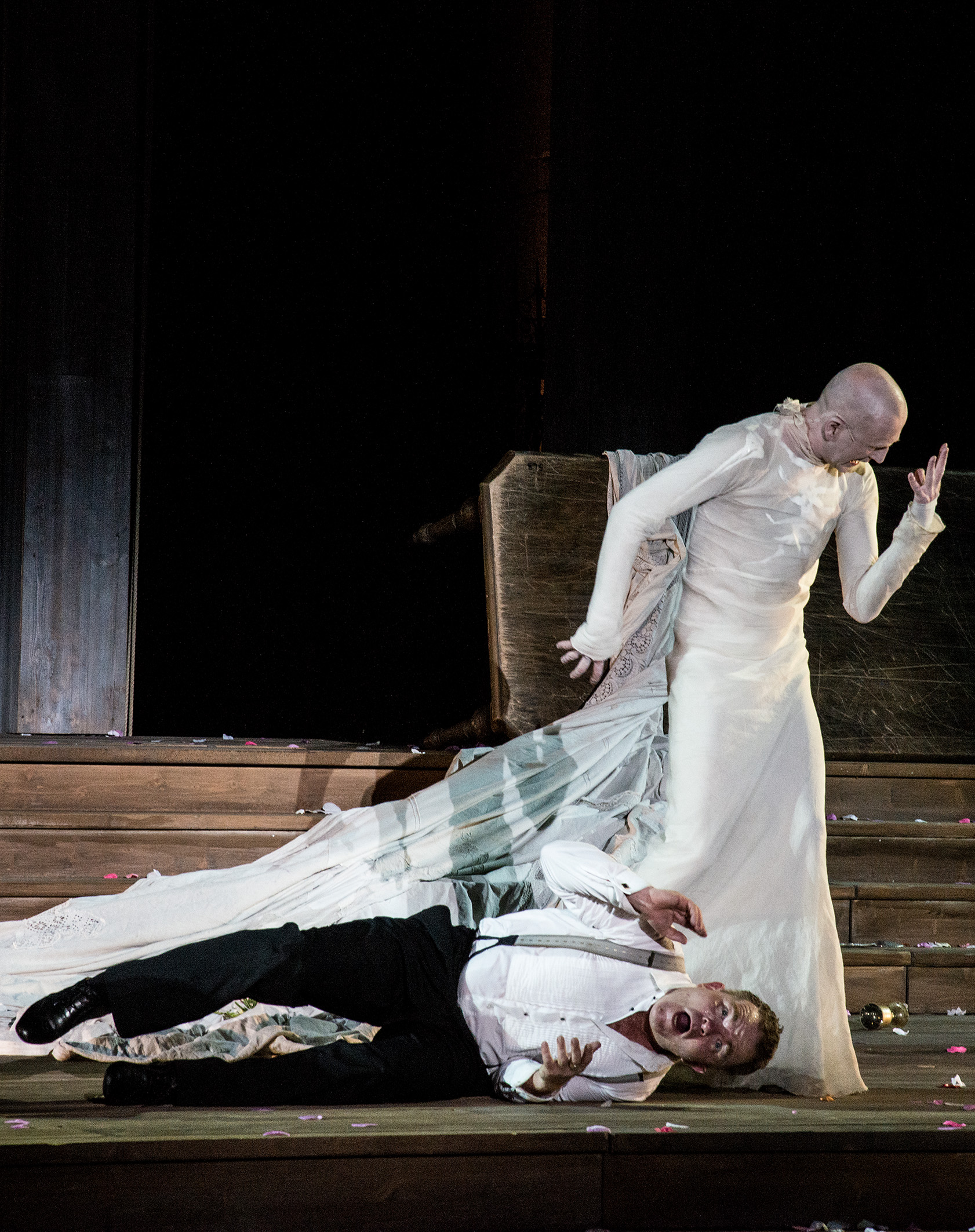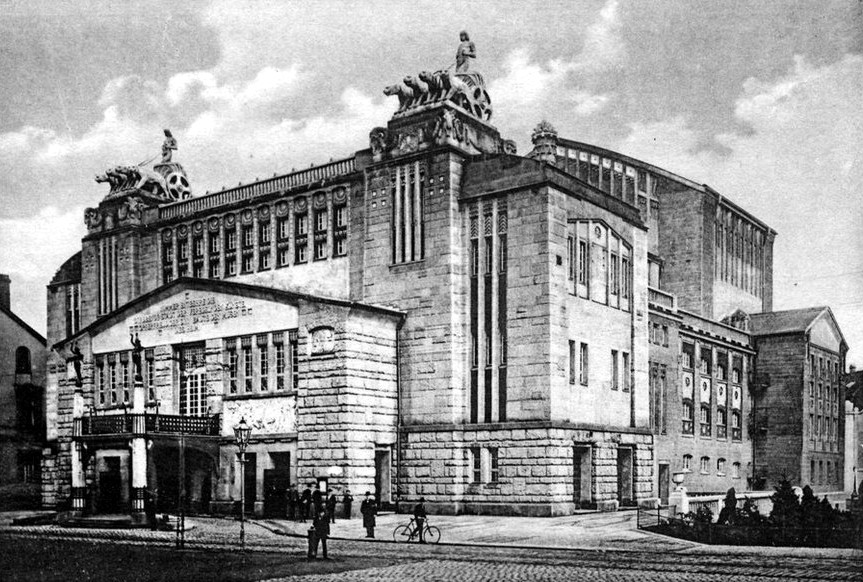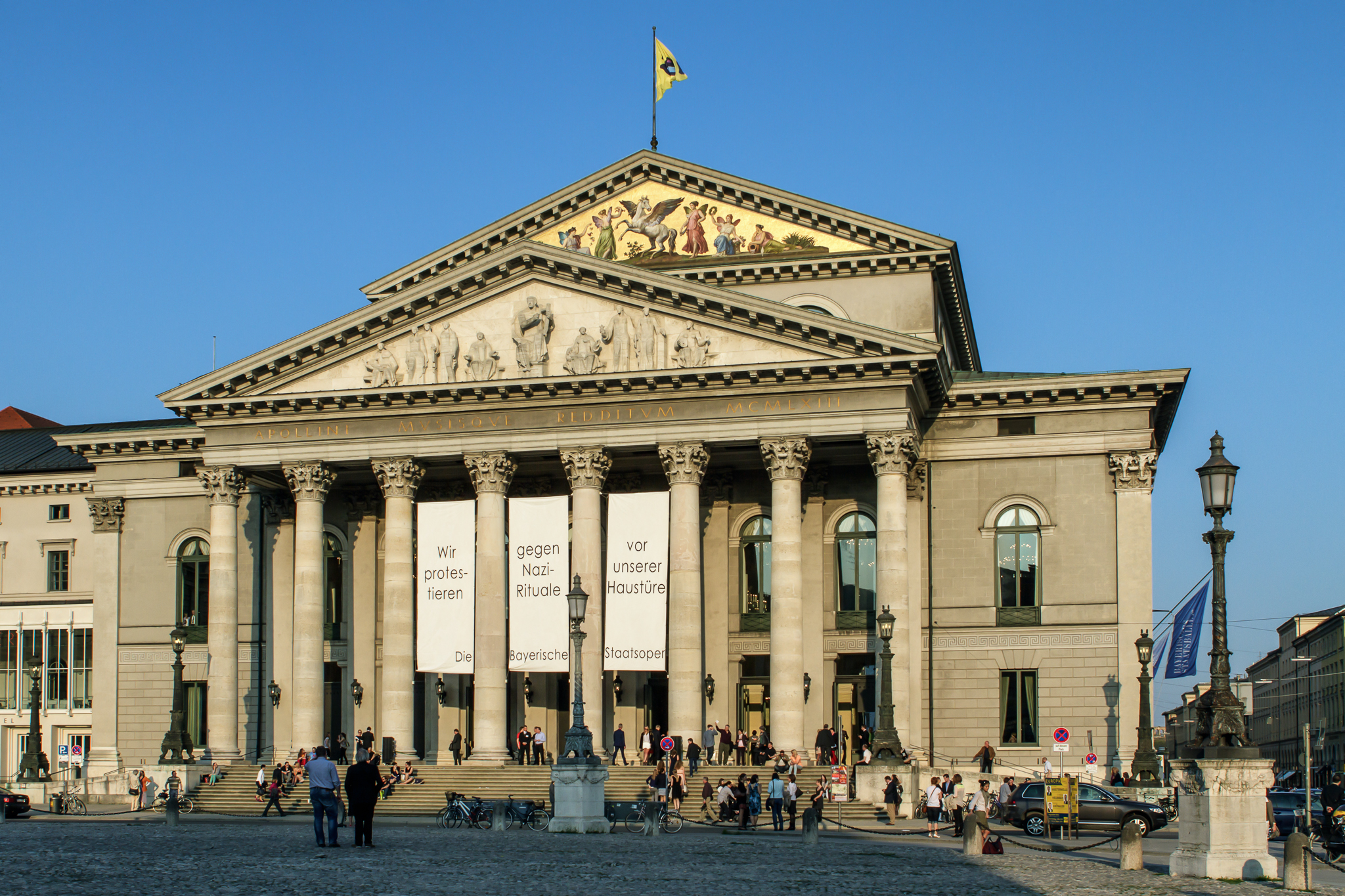|
Karl-Heinz Lehner
Karl-Heinz Lehner is an Austrian operatic and concert bass-baritone. Life Born in Eggenburg, Lehner began his musical education during hisschool years with the as soprano and alto. After the Abitur, he studied at the Universität für Musik und darstellende Kunst Wien, wo Leopold Spitzer in singing and Edith Mathis in Lied and oratorio were his teachers. After completing his training, Lehner received his first permanent engagement at the Stadttheater Bremerhaven, which he left after two seasons to move to the Opernhaus Dortmund, where he had the opportunity to work on an extensive repertoire. He then moved to the Aalto-Theater in Essen. He received guest contracts at the Komische Oper Berlin, the Volksoper Wien and the Opernhaus Graz, and he performed as King Marke at the Teatro dell'Opera di Roma and as Colline at the Bregenzer Festspiele. He made his debut as Sparafucile at the Hamburgische Staatsoper and as Orest at the Bayerische Staatsoper in Munich. Since 2006, ... [...More Info...] [...Related Items...] OR: [Wikipedia] [Google] [Baidu] |
Bass-baritone
A bass-baritone is a high-lying bass or low-lying "classical" baritone voice type which shares certain qualities with the true baritone voice. The term arose in the late 19th century to describe the particular type of voice required to sing three Wagnerian roles: the title role in ''Der fliegende Holländer'', Wotan/Der Wanderer in the ''Ring Cycle'' and Hans Sachs in '' Die Meistersinger von Nürnberg''. Wagner labelled these roles as ''Hoher Bass'' ("high bass")—see fach for more details. The bass-baritone voice is distinguished by two attributes. First, it must be capable of singing comfortably in a baritonal tessitura. Secondly, however, it needs to have the ripely resonant lower range typically associated with the bass voice. For example, the role of Wotan in ''Die Walküre'' covers the range from F2 (the F at the bottom of the bass clef) to F4 (the F above middle C), but only infrequently descends beyond C3 (the C below middle C). Bass-baritones are typically divide ... [...More Info...] [...Related Items...] OR: [Wikipedia] [Google] [Baidu] |
Opernhaus Graz
The Graz Opera (German: Oper Graz) is an Austrian opera house and opera company based in Graz. The orchestra of the opera house also performs concerts as the Graz Philharmonic Orchestra (''Grazer Philharmonisches Orchester''). History Opera had been performed in Graz since the 17th century, originally in a converted coach house on the Habsburg royal estates. The National Theatre (Schauspielhaus Graz), constructed in 1776, saw many early performances of Mozart's operas, although today (after many reconstructions) it is devoted to the performances of plays. The city's first dedicated opera house and the immediate predecessor of the Graz Opera was the Thalia Theatre, adapted in 1864 from an old circus hall. Plans for a new theatre suitable to the growing size and importance of the city and intended to be a "new home for German art" were first proposed in 1887. Designed by Ferdinand Fellner and Herman Helmer in the neo-baroque style, the Graz Opera was inaugurated in 1899 with ... [...More Info...] [...Related Items...] OR: [Wikipedia] [Google] [Baidu] |
Philippe Jordan
Philippe Jordan (born 18 October 1974) is a Swiss conductor and pianist. Biography Born in Zürich, the son of conductor Armin Jordan, he began to study piano at the age of six. At age eight, he joined the Zürcher Sängerknaben. He has acknowledged that he wished to become a conductor, like his father, at age 9. His violin studies began at age 11. At 16, he entered the Zürich Conservatory where he obtained his diploma in piano instruction, with honors. He studied theory and composition with the Swiss composer Hans Ulrich Lehmann and continued his piano studies with Karl Engel. At the same time, he worked as an assistant to Jeffrey Tate on Richard Wagner's ''Der Ring des Nibelungen'' at the Châtelet in Paris. In the 1994/1995 season, Jordan was appointed first Kapellmeister and assistant to James Allen Gähres at the Theater Ulm. The following year, he made his debut at the Théâtre Royal de la Monnaie in Brussels. He has since conducted at the Grand Théâtre in Geneva ... [...More Info...] [...Related Items...] OR: [Wikipedia] [Google] [Baidu] |
Georges Prêtre
Georges Prêtre (; 14 August 1924 – 4 January 2017) was a French orchestral and opera conductor. Biography Prêtre was born in Waziers ( Nord), and attended the Douai Conservatory and then studied harmony under Maurice Duruflé and conducting under André Cluytens among others at the Conservatoire de Paris. Amongst his early musical interests were jazz and trumpet. After graduating, he conducted in a number of small French opera houses sometimes under the pseudonym Georges Dherain. His conducting debut was at the Opéra de Marseille in 1946. He also conducted at the opera houses in Lille and Toulouse. His Paris debut was at the Opéra-Comique in Richard Strauss's '' Capriccio''. He was director of the Opéra-Comique 1955–1959. He conducted at the Lyric Opera of Chicago 1959–1971. He was conductor, 1959, and music director 1970–1971, at the Paris Opéra. He was principal conductor of the Vienna Symphony 1986–1991. His Royal Opera House, Covent Garden, debut came ... [...More Info...] [...Related Items...] OR: [Wikipedia] [Google] [Baidu] |
Saalbau Essen
Saalbau Essen is a concert venue in Essen, Germany, the home of the Essen Philharmonic. The original building was completed in 1902, and destroyed during World War II on 26 July 1943. It was rebuilt between 1949 and 1954 and completely renovated in 2003 and 2004. The Saalbau Essen is located a little bit south of the city center close to the Aalto Theatre. Since the 2013/2014 season Tomáš Netopil has been the music director of Essener Philharmonic. Also since 2013/2014 Hein Mulders has been the intendant of the Saalbau Essen. History The first concert venue at the same place, the so-called Stadtgartensaal, was opened in 1864. A new concert venue was built in 1901 at the same place – the first Saalbau. At the opening on 24 September 1904 conducted Richard Strauss. The design of the building was affected by the Art Nouveau movement. Gustav Mahler conducted here in 1906 at the 42. Tonkünstlerfestes (sound artist festival) of the Allgemeiner Deutscher Musikverein th ... [...More Info...] [...Related Items...] OR: [Wikipedia] [Google] [Baidu] |
Salzburg Festival
The Salzburg Festival (german: Salzburger Festspiele) is a prominent festival of music and drama established in 1920. It is held each summer (for five weeks starting in late July) in the Austrian town of Salzburg, the birthplace of Wolfgang Amadeus Mozart. One highlight is the annual performance of the play '' Jedermann'' (''Everyman'') by Hugo von Hofmannsthal. Since 1967, an annual Salzburg Easter Festival has also been held, organized by a separate organization. History Music festivals had been held in Salzburg at irregular intervals since 1877 held by the International Mozarteum Foundation but were discontinued in 1910. Although a festival was planned for 1914, it was cancelled at the outbreak of World War I. In 1917, Friedrich Gehmacher and Heinrich Damisch formed an organization known as the ''Salzburger Festspielhaus-Gemeinde'' to establish an annual festival of drama and music, emphasizing especially the works of Mozart. At the close of the war in 1918, the festival's re ... [...More Info...] [...Related Items...] OR: [Wikipedia] [Google] [Baidu] |
Wiener Musikverein
The ( or ; ), commonly shortened to , is a concert hall in Vienna, Austria, which is located in the Innere Stadt district. The building opened in 1870 and is the home of the Vienna Philharmonic orchestra. The acoustics of the building's 'Great Hall' () have earned it recognition alongside other prominent concert halls, such as the Konzerthaus Berlin, Konzerthaus in Berlin, the Concertgebouw in Amsterdam and Symphony Hall, Boston, Symphony Hall in Boston. With the exception of Boston's Symphony Hall, none of these halls was built in the modern era with the application of architectural acoustics, and all share a long, tall and narrow Shoebox style, shoebox shape. Building The 's main entrance is situated on Musikvereinsplatz, between Karlsplatz and . The building is located behind the Hotel Imperial that fronts on Kärntner Ring, which is part of the Vienna Ring Road (Ringstraße). It was erected as the new concert hall run by the Gesellschaft der Musikfreunde, Society of Frien ... [...More Info...] [...Related Items...] OR: [Wikipedia] [Google] [Baidu] |
Konzerthaus Dortmund
Theater Dortmund is a theatrical organization that produces operas, musicals, ballets, plays, and concerts in Dortmund, Germany. It was founded as the Stadttheater Dortmund in 1904. Supported by the German Government, the organization owns and operates several performance spaces. In 2010 the Ruhr district was a European Capital of Culture, Theater Dortmund is a partner of the related program ''RUHR.2010'' in the fields ''Music'' and ''Theater and Dance''.Dortmund at RUHR2010, including ''Musik'' and ''Theater und Tanz'' (in German) Stadttheater Dortmund [...More Info...] [...Related Items...] OR: [Wikipedia] [Google] [Baidu] |
Wiener Konzerthaus
The Konzerthaus is a concert hall located in Vienna, Austria, which opened in 1913. It is situated in the third district just at the edge of the first district in Vienna. Since it was founded it has always tried to emphasise both traditional and innovative musical styles. In 1890, the first ideas for a ''Haus für Musikfeste'' (House for music festivals) came about. The idea of the new multi-purpose building was to be more interesting to the broader public than the traditional Vienna Musikverein. In addition to the concert hall, the first drawings by Ludwig Baumann for the ''Olympion'' included an ice-skating area and a bicycle club. In an attached open air area, 40,000 visitors would be able to attend events. Although the drawings were not accepted, today an ice skating area is situated right next to the building. The Konzerthaus was finally built between 1911 and 1913. The architects were Fellner & Helmer; the work was done in cooperation with Ludwig Baumann. Performance fa ... [...More Info...] [...Related Items...] OR: [Wikipedia] [Google] [Baidu] |
Operabase
Operabase is an online database of opera performances, opera houses and companies, and performers themselves as well as their agents. Found at operabase.com, it was created in 1996 by English software engineer and opera lover Mike Gibb.Edward Schneider (29 July 2001),"Singing and Their Suppers" ''The New York Times''. Retrieved 13 May 2011. Initially a hobby site, it became his full-time occupation after three years. ''Opera'' magazine describes the Operabase website as "the most comprehensive source of data on operatic activity". Public website By its tenth anniversary, in 2006, the site received "about 10,000 visitors a day to the public site, who look at over four million pages a month between them. Of these, fewer than half use English, 17% use German, 12% Italian, 10% French, 9% Spanish." In autumn of that year the British magazine ''Opera Now'' reported that "Operabase has taken on the Herculean task of making he siteavailable to every European Union citizen in their own la ... [...More Info...] [...Related Items...] OR: [Wikipedia] [Google] [Baidu] |
Bayreuth Festival
The Bayreuth Festival (german: link=no, Bayreuther Festspiele) is a music festival held annually in Bayreuth, Germany, at which performances of operas by the 19th-century German composer Richard Wagner are presented. Wagner himself conceived and promoted the idea of a special festival to showcase his own works, in particular his monumental cycle and ''Parsifal''. Performances take place in a specially designed theatre, the Bayreuth Festspielhaus. Wagner personally supervised the design and construction of the theatre, which contained many architectural innovations to accommodate the huge orchestras for which Wagner wrote as well as the composer's particular vision about the staging of his works. The Festival has become a pilgrimage destination for Wagnerians and classical-music enthusiasts. Origins The origins of the Festival itself lie rooted in Richard Wagner's interest in establishing his financial independence. A souring of the relationship with his patron, Ludwig II o ... [...More Info...] [...Related Items...] OR: [Wikipedia] [Google] [Baidu] |
Bayerische Staatsoper
The Bayerische Staatsoper is a German opera company based in Munich. Its main venue is the Nationaltheater München, and its orchestra the Bayerische Staatsorchester. History The parent ensemble of the company was founded in 1653, under Electress consort Princess Henriette Adelaide of Savoy, when Giovanni Battista Maccioni's ''L'arpa festante'' was performed in the court theatre. In 1753, the Residence Theatre (Cuvilliés Theatre) was opened as a major stage. While opera performances were also held in the Prinzregententheater (completed in 1901), the company's home base is the Nationaltheater München on Max-Joseph-Platz. In 1875, the Munich Opera Festival took place for the first time. Sir Peter Jonas became the general manager in 1993, the first British general manager of any major German-speaking opera house. In 2008, Nikolaus Bachler became Intendant (general manager) of the opera company, and Kirill Petrenko became Generalmusikdirektor (GMD) in 2013. In 2014, the B ... [...More Info...] [...Related Items...] OR: [Wikipedia] [Google] [Baidu] |






